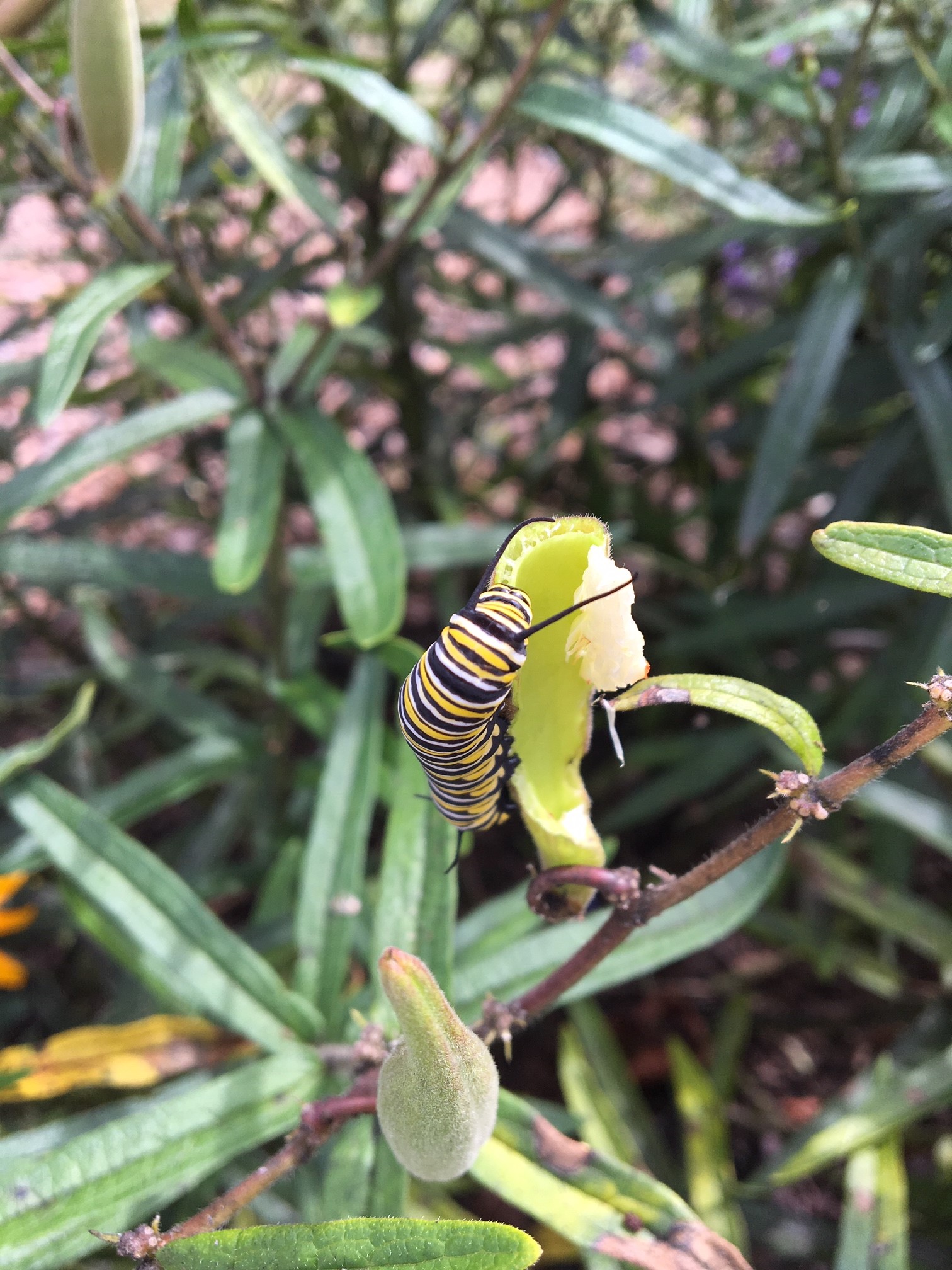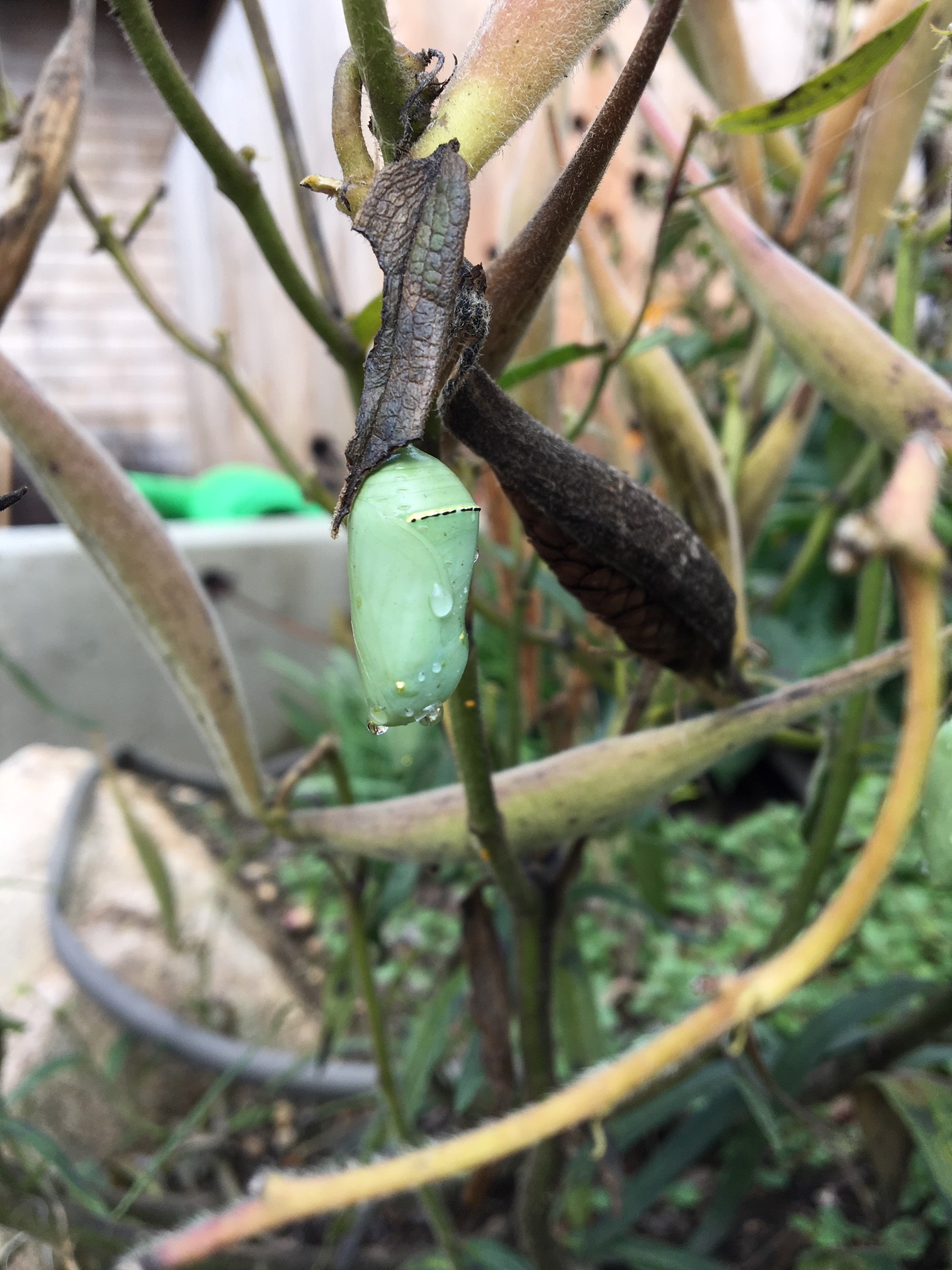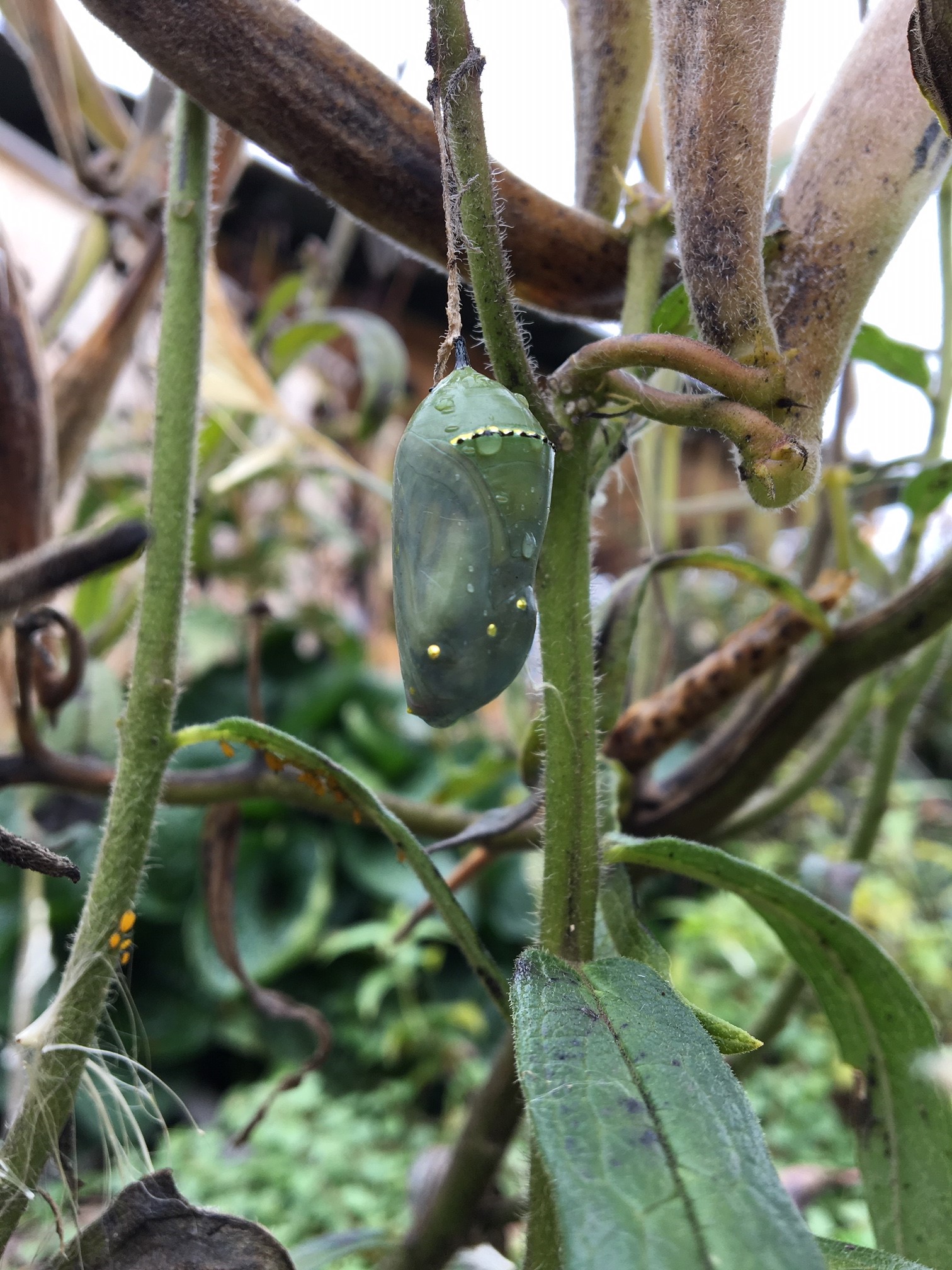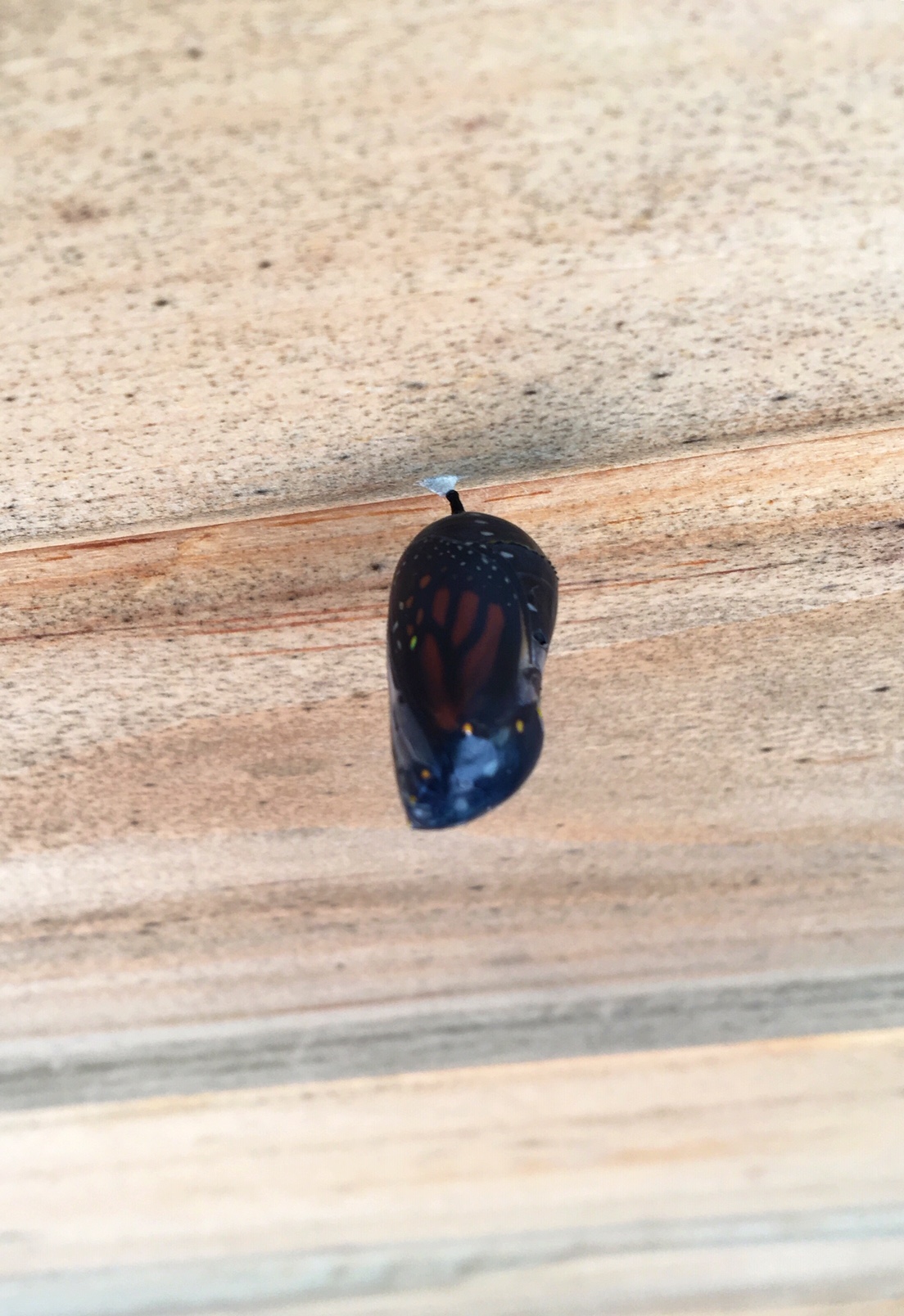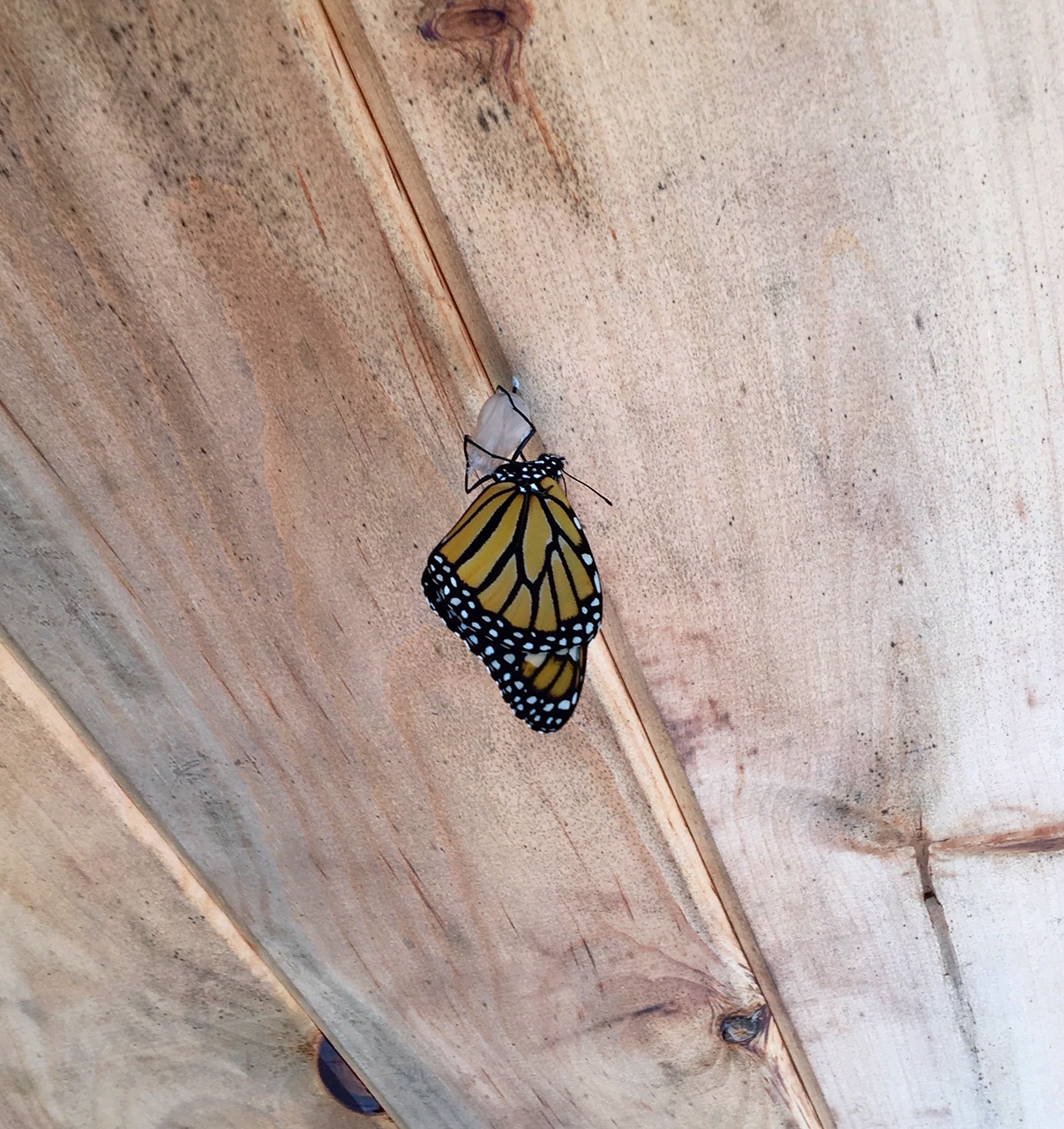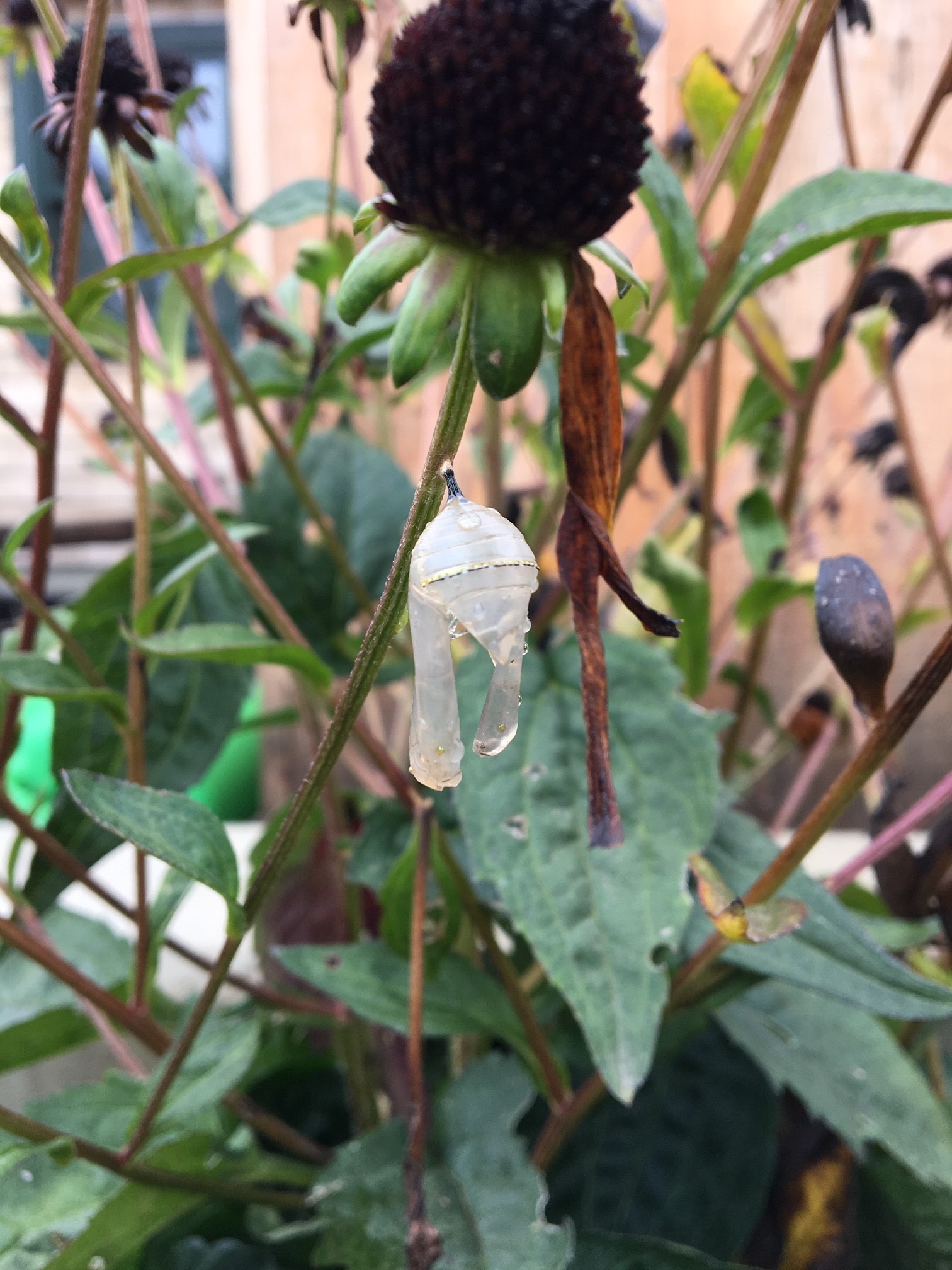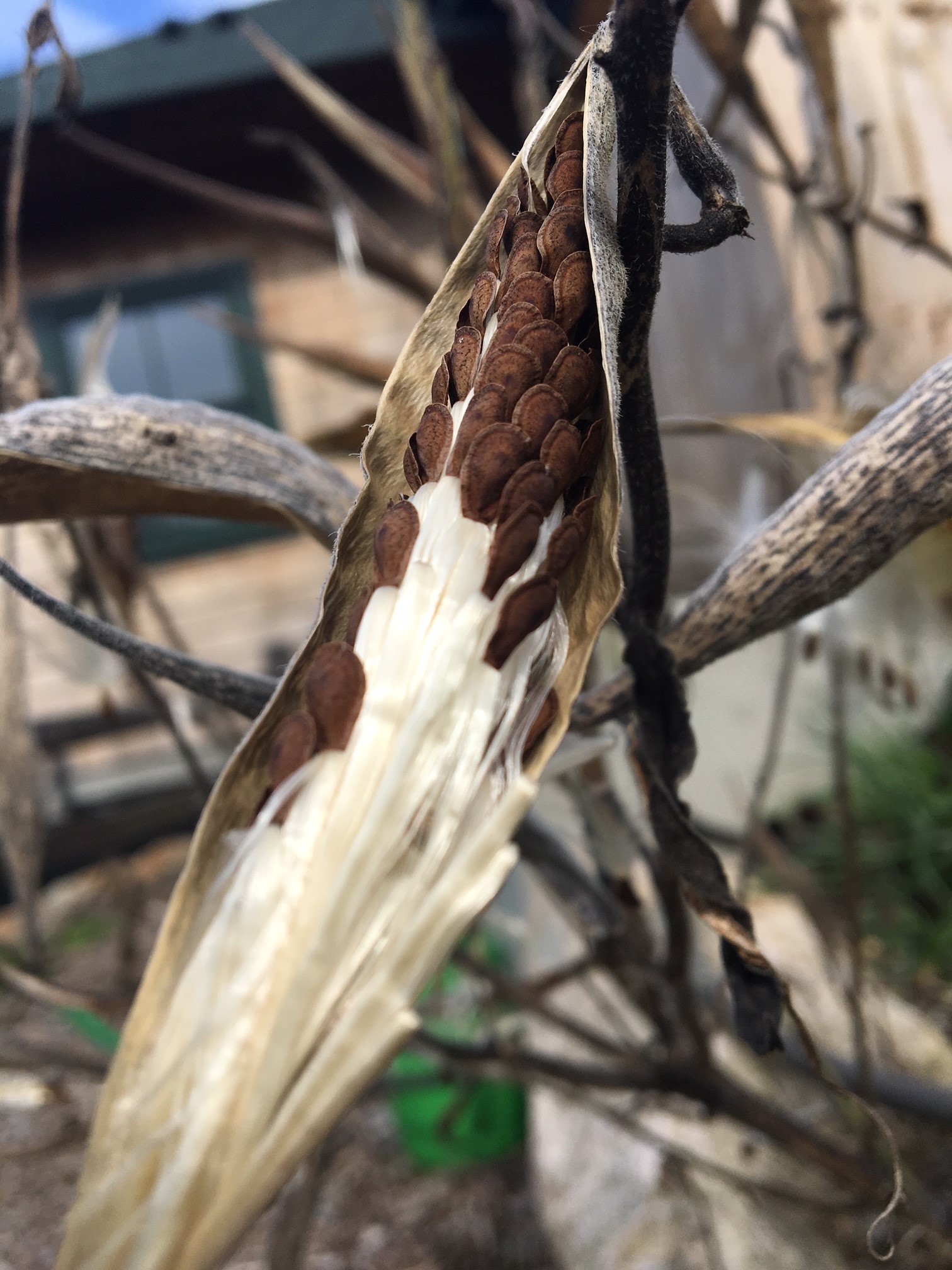A yearlong partnership with Stonehill College contributes to the ongoing success of Greening the Gateway Cities.
Community: The Foundation of Conservation
Where There’s Wildlands, There’s Wildlife
By Roxey Lay, Membership and Communications Coordinator
A female monarch drinks nectar from a sedum plant at Davis-Douglas Farm.
Last summer, the staff at Davis-Douglas Farm were fortunate enough to witness, up-close, the life cycle of multiple monarch butterflies. If you’ve visited the office before, you’ll know we have multiple gardens on the property, full of gorgeous plants and flowers that attract a number of pollinators; one such plant variety is swamp milkweed. Although typically found along the edges of ponds, lakes, and streams, swamp milkweed also acts as a great addition to any garden, both for its flowers and its connection to the monarch butterfly. In September, staff members first noticed a chrysalis attached to the porch roof of the Barn. Then, turning our attention to the nearby garden, we noticed a small army of monarch caterpillars munching away on the milkweed. Over the following weeks, these caterpillars shifted from using the plants as a food source, to using them as a location to attach and pupate. Excited at the opportunity to witness their metamorphosis, we periodically checked on them, documenting how each chrysalis changed; we even managed to witness a newly emerged monarch drying its wings!
Swamp milkweed, at the end of the summer.
Witnessing the process these insects go through is not only fascinating, but it’s a great reminder of how we all rely on nature to grow and survive. Unfortunately, monarch butterflies have been greatly affected by human impact on the environment. Milkweed is critical to the survival of monarch butterflies, as it is their only food source and they cannot complete their life cycles without it. [1] The use of herbicides resistant crops and dramatic shifts in seasonal temperatures have led to the loss of milkweed breeding habitats across the country and a significant decline in monarch numbers. [2] Although not formally listed as endangered, the U.S. Fish & Wildlife Service was petitioned in 2014 to protect the monarch butterfly under the Endangered Species Act; the listing decision is expected to be issued June 2019. [3]
When Wildlands protects a land parcel, it’s not only for the benefit of the surrounding community, it also maintains habitat for many species, both rare/endangered and common, that rely on that particular ecosystem. These large protected areas are incredibly important in maintaining the natural integrity of the region; however, they aren’t the only habitat local animal populations rely on. Gardens also act as habitat for various insects and, along with supporting local land trusts like Wildlands Trust, are a way you can personally help make a difference in the health of the region using your own back yard. For example, by planting milkweed and native nectar plants, you can help mitigate the habitat loss of the monarch butterfly while providing an important food source for bees and other pollinators.
Another way you can make a difference is by learning more about how various animals rely on the region’s natural landscapes and your affect on both them and their habitat. In past years, Wildlands has hosted presentations at our Community Conservation Barn on the topic of honey bees, owls, bats, and more with the intention of educating the public on these animals and raising awareness of the connection between wildlands and wildlife. Recently, we started our Wildlife on the Move lecture series, offering attendees a chance to learn more about regionally seasonal animals, as well as an opportunity to ask an expert any questions they may have. This month features a presentation by Professor Steven Reppert, MD on the monarch butterfly, its migration cycle, and a discussion of current threats and conservation efforts. We are also partnering with the Herring Ponds Watershed Association and hosting a presentation by Brian Bastarache and his students from Bristol County Agricultural High School on the endangered red-bellied cooter; a species of turtle that is only found in Plymouth County!
It’s through the support and commitment of you and others in which we succeed in protecting the region’s natural spaces for both our own health and enjoyment and for the animals that rely on them to survive. For more information on our Wildlife on the Move lecture series and other upcoming programs, visit: https://wildlandstrust.org/events
See below for some photos from last summer at the office:
Wildlands in an Urban Landscape
By Conor Michaud, Community Stewardship Program Coordinator
A newly planted sapling at a public park in Brockton.
Imagine a typical hot and humid July day in southern Massachusetts, with no breeze and the sun beating down. You decide, enough with the air conditioning, it’s time to breathe some fresh air for a change; so you step outside onto an asphalt driveway and greet the 90-degree day with a smile and a bead of sweat. You decide a good way to beat the heat is by visiting a local conservation area. As you begin your stroll along the woodland loop-trail, enjoying the shade of the trees, you stop at one of the benches on the trail for a short respite; you take in the cool breeze and appreciate the drastic change in temperature from your driveway to where you now sit.
Now, imagine a different scenario: On this same type of day, you stand in your driveway, sweating in the mid-day sun; you can’t believe how hot it is. Looking around, you notice there is no density to the trees along your street, only the occasional 30-foot outlier among the telephone poles, looming over asphalt; there is no nearby pond and no nature preserve within walking distance either. Realistically your only course of action to avoid this heat stress is to return to your home, the air conditioner on full-blast.
Saplings ready to be planted in Brockton.
Urban landscapes offer a multitude of benefits including public transportation, access to a variety of employment, more housing availability, and the innumerable benefits of living alongside other cultures and varying types of people; however, when left unaided, they can also result in dangerous public health conditions and environmental inequality. With minimal tree coverage, these areas become “heat islands”, where the temperature of pavement and roof surfaces can be significantly hotter than the air and, as a result, directly affect the public health and well-being of its residents. “Increased daytime temperatures, reduced nighttime cooling, and higher air pollution levels associated with urban heat islands can affect human health by contributing to general discomfort, respiratory difficulties, heat cramps and exhaustion, non-fatal heat stroke, and heat-related mortality.” [1]
GGC Brockton planting zone (click to enlarge)
In 2012, Wildlands entered into the city of Brockton’s conservation scene through our acquisition of Brockton Audubon Preserve and since then, while we have continued to preserve crucial conservation lands within the city-limits (managing and restoring Stone Farm), we’ve asked ourselves, how could we further our mission in Brockton? How could Wildlands address the ongoing environmental justice issues that affect the residents? One such way, is our work through the Greening the Gateway Cities (GGC) program. In 2017, Wildlands partnered with the Brockton chapter of GGC and, we are proud to report, we’re on track to successfully plant over 2,400 trees by June 2020. Due to its success, for the remainder of the program, we are looking to address a wider range of benefits beyond the economic relief aspects, including the improvement of resident’s quality of life. Our conscious transition to promote the physical and mental health benefits are in an effort to support the concerning public health issues many urban neighborhoods face today.
Wildlands is proud to be a partner in the project and through these collaborative efforts our conservation efforts in Brockton have gained a greater depth, our capacity to address environmental justice issues has been strengthened, and we have become a part of the greater conversation surrounding the future of Massachusetts’s Gateway Cities. While few land trusts have taken on similar environmental justice work, we believe it has been a crucial landmark in our growth as an organization allowing us to not only to tackle these pressing issues but to expand our capacity to protect land in urban areas and bring a voice for environmental conservation, education, and exposure to the commonwealth.
For more information on Greening the Gateway Cities, visit: https://wildlandstrust.org/greening-the-gateway-cities
What's Up With Wetlands?
By Roxey Lay, Membership and Communications Coordinator
EPA map displaying coastal wetlands and how far inland they extend (click to enlarge).
Swamps, marshes, bogs, and fens; all ecosystems defined by various sub-types and characteristics with one thing in common: they are all wetlands. World Wetlands Day was February 2, marking the date the Convention on Wetlands was adopted in 1971 and raising awareness of wetlands and their vital role to our planet. Massachusetts was the first state in the nation to adopt wetland protection laws during the 1960s; however, since the Colonial Period, roughly one-third of the state’s wetlands have been destroyed[1]. According to the EPA, “wetlands in coastal watersheds are experiencing disproportionate losses compared to wetlands in the rest of the country, making them particularly important areas for protection”[2]. Wildlands’ work to protect undeveloped land throughout the region includes the protection of wetlands. In fact, nearly all of the properties in Wildlands’ portfolio contain some type of wetland and provide habitat for many different species throughout the region; some of which are rare or endangered, such as the eastern box turtle and northern red-bellied cooter.
Drone view of Raven Brook in Middleborough.
Recently, I spoke with Brad Holmes, manager of Environmental Consulting & Restoration, LLC (ECR) to learn about what wetlands are and how they impact Southeastern Massachusetts. Located in Plymouth, ECR specializes in wetland consulting, permitting and restoration, and Brad, a professional wetland scientist (PWS), has worked with Wildlands at Great River Preserve and most recently, on the ecological restoration project along the shore of Halfway Pond. Read on to learn about wetlands and their significance to our region:
What is a wetland?
A wetland is an area where groundwater is located at or near the surface and where the vegetative community is dominated by plants adapted to live in saturated soil conditions. Wetlands often border on creeks, rivers, streams, ponds, lakes etc., but may also be isolated. Wetlands are [determined] by assessing three specific site conditions that include vegetation, soil, and hydrology. By definition, a wetland must include 2 of 3 conditions: a dominance of wetland vegetation, hydric soils, and/or hydrological conditions.
What is a wetland scientist?
A Professional Wetland Scientist is an individual that has been certified by the Society of Wetland Scientists based on academic and work experience in wetland science. As a PWS we work to assess and manage wetland resource areas throughout Massachusetts. Our work includes field delineation of wetlands based on specific environmental conditions (i.e. vegetation, soils & hydrology) as well as designing and permitting projects through the applicable local, state and federal regulatory authorities.
In addition to your work as a PWS, you are certified by the MA Arborists Association as an arborist, how does this influence your approach to your work?
As an MA Certified Arborist, I approach projects with a special consideration towards the care of trees, specifically when designing wetland restoration or wetland replication projects.
North River in Marshfield.
What are the benefits of wetlands?
Wetlands provide benefits to landowners and the public, [including] protection of public and private water supply, protection of groundwater supply, flood control, storm damage prevention, prevention of pollution, protection of fisheries and protection of wildlife habitat.
Why is important to protect them?
Wetlands act as a first line of defense for floodwater from storms. They also act as a filter to pollutants in our water supply. They [also] provide a specific habitat that many wildlife and fish need to survive.
Do wetlands have any significance to Southeastern Massachusetts?
There are many extensive wetland systems within Southeastern Massachusetts. For instance, the North River system in Scituate, Marshfield, Norwell, and Pembroke. Also consider the Taunton River system, the extensive freshwater ponds and the 250+ miles of coastline in Massachusetts.
It is important for property owners and the general public to be aware of the wetlands in their community and where they can seek guidance in protecting the wetland resource areas.
What is the current state of wetlands in this region? Are they threatened? If so, what can people do to help?
Wetlands in Massachusetts are protected by the Massachusetts Wetlands Protection Act and associated Wetland Regulations. [These] spell out specific performance standards for work within or nearby (buffer zone) wetland resource areas. It is important for property owners and the general public to be aware of the wetlands in their community and where they can seek guidance in protecting the wetland resource areas. Many towns in Massachusetts have a local Conservation Commission that works to protect the resource areas in their community.
What do you think the future of wetlands is?
Wetlands will be protected. The next task is protecting more land buffering wetlands, which is the current struggle.
Wetlands at Striar Conservancy, Halifax
Want to learn more about wetlands and whether there are any near your home? Talk to your local Conservation Commission, go to the State’s website on wetlands, or, if there is a Wildlands property near you, ask us what type of wetland is on the property and how you can help in maintaining its integrity for the benefit of your town and the animals that rely on its habitat. I’d like to thank Brad for taking the time to answer my questions and providing some great insight on the importance of wetlands and their impact on our region.




